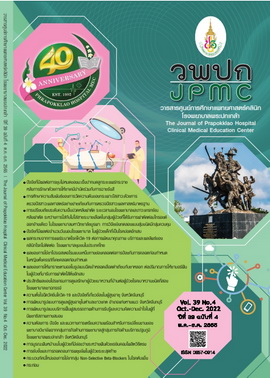Kratom
Main Article Content
Abstract
Kratom, scientific name Mitragyna speciosa (Korth.) Havil, is in the family Rubiaceae. The substances that are most common are indole alkaloids and the main active substance is Mitragynine. Pharmacological effects include pain relief, anti-inflammatory, antipyretic, and increase the level of neurotransmitter congestion resulting in antidepressant effects. inhibits the secretion of acid in the gastrointestinal tract Reduce the level of sugar in the blood stream. However, kratom has been researched to be toxic to the liver and kidneys. And there are side effects if used for a long time, such as dry skin, loss of appetite, dark lips, frequent urination, and may have mental disorders.
Article Details

This work is licensed under a Creative Commons Attribution-NonCommercial-NoDerivatives 4.0 International License.
References
Leong Bin Abdullah MFI, Singh D. The adverse cardiovascular effects and cardiotoxicity ofKratom( MitragynaspeciosaKorth.): a comprehensive review. Front Pharmacol [Internet]. 2021 [cited 2022 Feb 7];12:726003. Available from: https://doi.org/10.3389/fphar.2021.726003
Cinosi E, Martinotti G,Simonato P,Singh D,Demetrovics Z,Roman-Urrestarazu A, et al. Following "the roots" of Kratom (Mitragynaspeciosa): the evolution of an enhancer from a traditional use to increase work and productivity in Southeast Asia to a recreational psychoactive drug in western countries. Biomed Res Int [Internet]. 2015 [cited 2022 Feb 7];2015:968786. Available from: https://doi.org/10.1155/2015/968786
Grewal KS. Observations OX the pharmacology of mitragynine. J PharmacolExpTher 1932; 46:251-71.
Wungsintaweekul J. Kratom [Internet]. Nonthaburi: Center for Continuing Pharmaceutical Education; 2017 [cited 2022 Feb 8]. Available from: https://ccpe.pharmacycouncil.org/index.php?option=article_detail&subpage=article_detail&id=251
Harun N, Hassan Z,Navaratnam V, Mansor SM,Shoaib M. Discriminative stimulus properties of mitragynine (kratom) in rats. Psychopharmacology (Berl) 2015;232:2227-38.
Takayama H. Chemistry and pharmacology of analgesic indole alkaloids from the rubiaceous plant, Mitragynaspeciosa. Chem Pharm Bull (Tokyo) 2004;52:916–28.
Rungruang W. Toxicology of Kratom (Mitragynaspeciosa). Thai J Hosp Pharm. 2020;30:118-24.
Sabetghadam A, Ramanathan S, Sasidharan S, Mansor SM. Subchronic exposure to mitragynine, the principal alkaloid of Mitragynaspeciosa, in rats. J Ethnopharmacol 2013; 146:815-23.
Harizal SN, Mansor SM, Hasnan J, Tharakan JK, Abdullah J. Acute toxicity study of the standardized methanolic extract of Mitragyna speciosa Korth in rodent. J Ethnopharmacol 2010;131:404-9.
Idayu NF,Hidayat MT,Moklas MA,Sharida F,Raudzah AR,Shamima AR, et al. Antidepressant-like effect of mitragynine isolated from MitragynaspeciosaKorth in mice model of depression. Phytomedicine 2011;18:402–7.
Chittrakarn S,Sawangjaroen K,Prasettho S,Janchawee B,Keawpradub N.Inhibitory effects of ratom leaf extract (MitragynaspeciosaKorth.) on the rat gastrointestinal tract. J Ethnopharmacol 2008;116:173-8.
Purintrapiban J, Keawpradub N,Kansenalak S,Chittrakarn S,Janchawee B,Sawangjaroen K.Study on glucose transport in muscle cells by extracts from Mitragynaspeciosa (Korth) and mitragynine. Nat Prod Res 2011;25:1379-87.
Parthasarathy S, Azizi JB, Ramanathan S, Ismail S, Sasidharan S, Said MI, et al.Evaluation of antioxidant and antibacterial activities of aqueous, methanolic and alkaloid extracts from Mitragynaspeciosa (Rubiaceae family) leaves. Molecules2009;14:3964-74.
Utar Z,Abdul Majid MI,Adenan MI,Amar Jamil MF,Lan TM.Mitragynine inhibits the COX-2 mRNA expression and prostaglandin E2 production induced by lipopolysaccharide in RAW264.7 macrophage cells.J Ethnopharmacol 2011;136:75-82.

